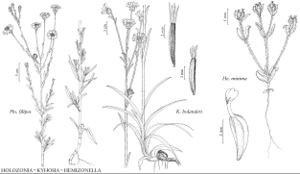Kyhosia bolanderi
Novon 9: 466. 1999.
IllustratedEndemic
Basionym: Anisocarpus bolanderi A. Gray Proc. Amer. Acad. Arts 7: 360. 1868
Synonyms: Madia bolanderi (A. Gray) A. Gray
Revision as of 22:43, 29 July 2020 by imported>Volume Importer
Leaf-blades (proximal) 5–35 cm × 4–15 mm. Phyllaries 7–14 mm. Disc corollas 5–8 mm. Ray cypselae 5–7 mm; pappi 0 or to 0.7 mm. Disc cypselae 5–9 mm; pappi 1–5 mm. 2n = 12.
Phenology: Flowering Jul–Sep.
Habitat: Meadows, stream banks
Elevation: 1000–2600 m
Distribution

Calif., Nev., Oreg.
Discussion
Kyhosia bolanderi is unusual among continental tarweeds for occurring in wet, montane habitats, in the North Coast Ranges, Klamath Ranges, and Sierra Nevada of the California Floristic Province. Ecologically, K. bolanderi is similar to another self-incompatible, robust, rhizomatous, perennial tarweed, Raillardella pringlei, which occurs with K. bolanderi in the Klamath Ranges.
Selected References
None.
Lower Taxa
None.
... more about "Kyhosia bolanderi"
introrse +
connate +
herbaceous +
scarious +
absent +
hirsute +
papillate +
continuous +
decurrent +
linear to linear-elliptic +
lance-linear to linear +
lobed;usually spatulate;oblanceolate +
winged;ribbed;winged;ribbed +
1;15 +
stigmatic +
absent +
zygomorphic +
bright-yellow +
pubescent +
monomorphic +
dimorphic +
staminate +
terete +
staminate +
sessile +
alternate +
straight +
distinct +
proximal +
1;5 +
bisexual +
dispersed +
singly +
discoid +
indeterminate +
Present +
surrounding +
less campanulate;hemispheric +
4mm;15mm +
deltate +
2-carpellate +
inferior +
attached +
anatropous +
persistent +
falling +
absent +
0-0.7 mm +
coroniform +
tough +
thick +
absent +
connate +
persistent +
distinct +
falling +
absent +
unequal +
opposite +
Novon +
1999 +
pistillate +
absent +
fertile +
paleate +
glabrous +
flat;convex +
fibrous +
exalbuminous +
modifed +
absent +
alternate +
erect +
2-branched +
papillate +
Kyhosia bolanderi +
Kyhosia +
species +
cylindric +
equaling +
shorter +
perennial +
